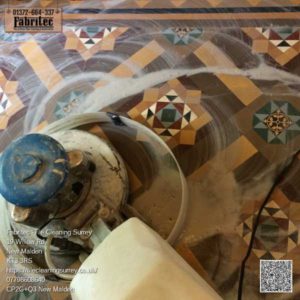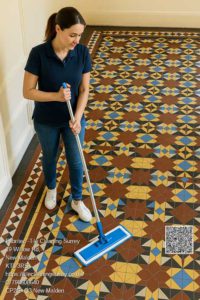Revitalise Your Home with the Elegant Restoration of Victorian Tiles
Victorian hallway tiles not only infuse your space with a sense of historical sophistication but also necessitate careful cleaning and maintenance to retain their captivating charm. Renowned for their intricate patterns and rich colours, these tiles were a defining feature of 19th-century architecture and continue to be highly sought after in contemporary interiors. However, as time progresses, unique challenges arise that demand a skilled approach to their upkeep. With the right care, you can restore their original splendour, ensuring they perpetually enhance the character and elegance of your home.
Exploring the Cultural Importance and Heritage of Victorian Tiles
Victorian tiles transcend mere flooring; they are remarkable artifacts that narrate a tale of craftsmanship from a golden age. Made from robust clay and adorned with stunning designs, these tiles encapsulate a rich cultural legacy that warrants preservation. By undertaking the restoration of these historical treasures, homeowners not only contribute to the safeguarding of cultural heritage but also enhance the value and visual appeal of their properties.
Recognising Common Issues in Neglected Victorian Hallway Tiles
- Loss of Lustre: A common concern with neglected Victorian tiles is the accumulation of wax, a protective coating many homeowners apply to boost shine and protect surfaces. Over time, this wax accumulation can obscure the tiles, leading to a dull and lifeless appearance. Insufficient maintenance can trap dirt and dust within the wax, further diminishing the vibrancy of the tiles and complicating the restoration process.
- Visible Scratches: In the absence of adequate cleaning and care, scratches and discolouration can tarnish the surfaces of Victorian tiles. Typically, this degradation arises from the presence of grit and dirt, or the use of harsh cleaning methods that wear down the tile surface. The once vibrant colours and intricate designs may become obscured, resulting in unsightly blemishes and a deterioration of the tiles' inherent charm.
- Erosion of Original Character: Perhaps the most disheartening effect of neglect is the erosion of original character in Victorian tiles. Each tile was crafted with meticulous attention to detail, designed to enhance the beauty of a room. Over time, neglect can lead to faded patterns and washed-out colours, rendering your space feeling outdated and devoid of its historical allure.
Step-by-Step Guide for Effectively Restoring Victorian Tiles

Step 1: Effective Techniques for Wax Removal
The initial phase of the restoration process involves meticulously stripping away layers of old wax using non-abrasive and tile-safe cleaning products that efficiently eliminate the buildup without harming the underlying surface. This crucial step ensures that the tiles' natural beauty is effectively restored.
Step 2: Comprehensive Deep Cleaning for Enhanced Vibrancy
A professional deep cleaning procedure specifically targets stubborn grout lines, persistent stains, and ingrained dirt, unveiling the tiles’ original vibrancy. This critical stage is essential for addressing any discolouration and ensuring that the tiles are revitalised to their former glory.
Step 3: Implementing Proactive Moisture Management
Older properties frequently lack adequate modern moisture barriers, making moisture control imperative. We utilise dehumidifiers or breathable sealants to avert future moisture complications, ensuring that your tiles maintain their excellent condition for years ahead.
Step 4: Sealing for Long-Term Protection and Longevity
Finally, we apply a breathable impregnating sealer that offers protection against moisture and stains, ensuring long-lasting durability while preserving their stunning appearance. This last step is vital for maintaining the quality of your tiles over time.
Essential Maintenance Strategies After Restoration
-
1. Utilise pH-Neutral Cleaners for Optimal Tile Care
When maintaining your Victorian tiles, it is essential to select appropriate cleaning agents that preserve their appearance and safeguard the sealant. pH-neutral cleaners are specifically developed to gently cleanse surfaces without stripping the sealer or causing damage to the tiles. These gentle formulations help prevent abrasion, discolouration, or fading over time.
Recommended pH-Neutral Cleaners for Victorian Tiles:
- LTP Wash – Ideal for regular cleaning without jeopardising the sealant.
- Fila Multisurface Cleaner – A gentle yet effective solution perfect for the upkeep of tile surfaces.
2. Establish a Regular Cleaning Regimen to Prevent Accumulation

Even post-restoration, dirt, dust, and grease can accumulate over time. Implementing a consistent cleaning regimen helps avert buildup, ensuring that your tiles continue to look attractive. Regularly sweep or vacuum to eliminate dirt and debris, and mop with a damp cloth to keep the tiles clean and shiny.
- Tip: Employ a microfiber mop for gentle yet effective cleaning that will not scratch the tile surface.
3. Avoid Abrasive Tools and Harsh Chemicals
When caring for Victorian tiles, it is imperative to refrain from using abrasive brushes, harsh scrubbers, or chemical cleaners that could damage the sealant or scratch the tile surface. Abrasive tools can create unsightly scratches, dulling the shine and making the tiles more vulnerable to wear.
Items to Avoid When Cleaning:
- Steel wool pads
- Bleach or ammonia-based cleaners
- Abrasive scrubbing brushes
Instead, opt for soft, non-abrasive sponges or cloths to maintain the tiles' integrity.
4. Timely Intervention for Minor Wear and Tear
Over time, minor wear and tear on your tiles is inevitable, but there are effective methods to address these issues without compromising the overall finish. If you discover small stains or spots that are challenging to remove with standard cleaning, it’s crucial to treat them promptly to avert further damage.
- Spot Cleaning: For stubborn stains, gently rub the area with a mild cleaner and a soft cloth.
- Surface Scuffs: Light scuffs can often be buffed out using a microfiber cloth. For more persistent marks, a thin layer of sealer can restore the finish.
Tip: Do not delay in cleaning up spills. Staining liquids such as wine, coffee, or oil can set quickly, making removal significantly more difficult later.
5. Reapply the Sealer Periodically for Enduring Protection
While the initial restoration includes sealing the tiles, it is advisable to reapply the impregnating sealer every few years, contingent on foot traffic and wear. The sealer provides a vital layer of protection against moisture, dirt, and grime, which could otherwise penetrate the tiles and cause damage.
Steps to Apply Sealer Effectively:
- Ensure the surface is completely clean and dry before reapplying the sealer.
- Apply the sealer in thin, even coats, allowing each coat to dry thoroughly before applying the next.
- Pay particular attention to high foot traffic areas to ensure they receive adequate protection.
The Benefits of Considering Professional Cleaning for Victorian Hallway Tiles
While some homeowners may contemplate DIY restoration, engaging a professional tile restoration service frequently results in superior outcomes. Professionals possess the necessary equipment, expertise, and understanding to manage the delicate nature of Victorian tiles, ensuring a successful restoration with minimal risk of damage.
Tile restoration specialists can offer:
- Comprehensive cleaning and restoration services tailored specifically for Victorian tiles.
- Expertise in moisture control and sealing to safeguard your tiles from future deterioration.
- Professional advice on effective long-term maintenance for your tiles.
If you're contemplating restoring your Victorian tiles, seeking professional assistance can greatly enhance the results.
Looking for Expert Assistance? Choose the Professionals
While DIY cleaning is an option, hiring a professional ensures that no damage is inflicted on the original surface of your tiles.
Frequently Asked Questions Regarding Victorian Hallway Tile Cleaning
What Cleaning Frequency is Recommended for My Victorian Hallway Tiles?
Light cleaning should be conducted weekly, with deep cleaning and resealing every 1–2 years, depending on foot traffic levels.
Can I Use Bleach or Vinegar on My Victorian Tiles?
Absolutely not. These harsh substances can erode the tiles and damage the sealant. Stick to using only pH-neutral cleaners.
Is Wax Removal Necessary Prior to Sealing?
Yes, removing wax is crucial to ensure that sealers adhere effectively and provide long-lasting protection for your tiles.
Should I Engage a Professional for Tile Restoration Services?
For optimal results and to prevent accidental damage, hiring a professional is highly advisable.
The Enduring Allure of Victorian Hallway Tiles
Victorian hallway tiles are exquisite remnants of history that, with the right care and maintenance, can remain striking for generations. Whether you are restoring a property in Chertsey or merely refreshing your hallway, investing in the upkeep of these unique floors is always a prudent decision.
The Article: Uncover the Shocking Transformation of a Neglected Victorian Hallway In Chertsey first appeared on https://tilecleaningsurrey.co.uk
The Article Victorian Hallway Tiles Cleaning Chertsey: How to Restore & Maintain Timeless Floors first appeared on https://fabritec.org
The Article Victorian Hallway Tiles Cleaning: Restore and Care for Timeless Floors Was Found On https://limitsofstrategy.com

